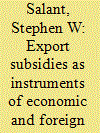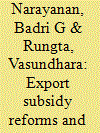| Srl | Item |
| 1 |
ID:
072640


|
|
|
|
|
| Publication |
Santa Monica, Rand Corporation, 1984.
|
| Description |
vii, 37p.
|
|
|
|
|
|
|
|
|
|
|
|
Copies: C:1/I:0,R:0,Q:0
Circulation
| Accession# | Call# | Current Location | Status | Policy | Location |
| 024935 | 382.63/SAL 024935 | Main | On Shelf | General | |
|
|
|
|
| 2 |
ID:
133886


|
|
|
|
|
| Publication |
2014.
|
| Summary/Abstract |
The World Trade Organization (WTO) recommends all members to phase out their export subsidies. While this may render export-oriented industries susceptible to tighter competition in their import markets, productivity improvements could help offset such disadvantages. This article explores the interaction between these two different aspects to evaluate the economy-wide impact of export subsidy reforms and productivity improvements in the Indian textile and clothing sector. Our analysis stands on various policy simulations applying the general equilibrium model of the Global Trade Analysis Project (GTAP; Hertel, 1997). The welfare impacts of the removal of Indian textile and clothing subsidies in terms of equivalent variation shows that India is expected to encounter a loss of about 71.5 million US$, while other Asian countries may gain about 218 million US$. In a different scenario, we simulate the impact of a complete phase-out of subsidies provided to the textile and clothing industry of India and a simultaneous increase in total factor productivity growth to 3.5 per cent. This leads to a net positive welfare change and an expected gain of about US$ 13.17 million in terms of allocative efficiency. We conclude that merely removing subsidies is not enough, as is often argued by Indian policymakers that such a policy reversal might result in contraction of the sector. Investments in total factor productivity should come about simultaneously, probably by employing surplus funds from saved subsidy payments in areas like research and development and infrastructure. This conclusion may be qualitatively generalised for any sector in the world, which is examined for export subsidy reforms, but similar economy-wide studies are recommended for specific cases.
|
|
|
|
|
|
|
|
|
|
|
|
|
|
|
|